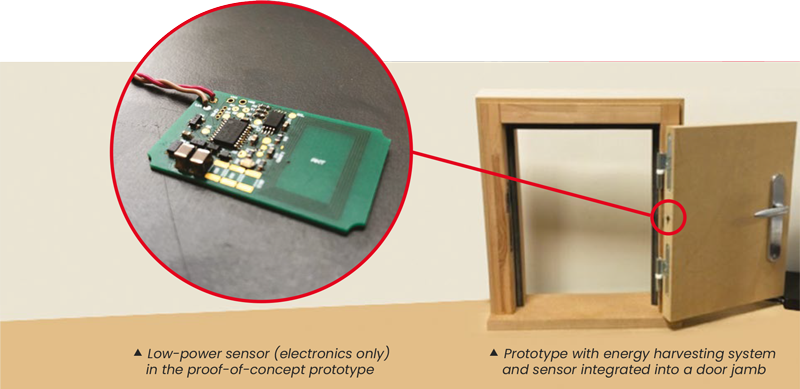PowerFree Count
A self-contained energy harvesting system and sensor integrated into a door to monitor usage
An electromagnetic element serves as both a sensor and an energy harvester. Each time force is exerted on the element (in this case, when the door is opened or closed), energy is harvested, and the measurement is incremented on a non-volatile memory. The data can then be read with an external device like a smartphone using wireless NFC technology.
The sensor is low-cost and compact, making it ideal for integration into a variety of products. The sensing element also harvests enough energy to power the electronics, eliminating the need for batteries (and the associated maintenance). The device also has a capacitor for storage, making the electronics even simpler and more compact than systems that rely on rechargeable batteries.
What it can do
The door sensor demonstrator developed for Simonetti is a prime example of how integrated batteryless sensors can support product servitization and new pay-per-use business models in this field. Here, the number of times a door is opened and closed is measured. The data gathered can be used for maintenance purposes or to track building or room occupancy, for example. The same technology has already been used in:
Connected light switches (with Legrand)
With further development, it could also enable integrated product lifecycle traceability systems such as digital product passports
|
What makes it unique
What sets this sensor apart is that it is very low power and low cost and is easy to integrate into a variety of products. CEA-Leti was able to use off-the-shelf sensors and program and integrate a very-low-power microcontroller to build this proof-of-concept prototype for window and door manufacturer Simonetti in research supported by the Auvergne Rhône Alpes region.
|

What’s next?
nextThe electrical conversion efficiency is currently being improved so that more measurements can be integrated with a single energy harvester and to enable more compact devices in the future. A microcontroller and memory could be integrated on a single ASIC optimized for power consumption. Other wireless communication protocols could also be implemented to broaden the device’s connectivity. Finally, other sensors (temperature, light, impact, photovoltaic cells, etc.) could be integrated into the system to enable more versatile devices.
|